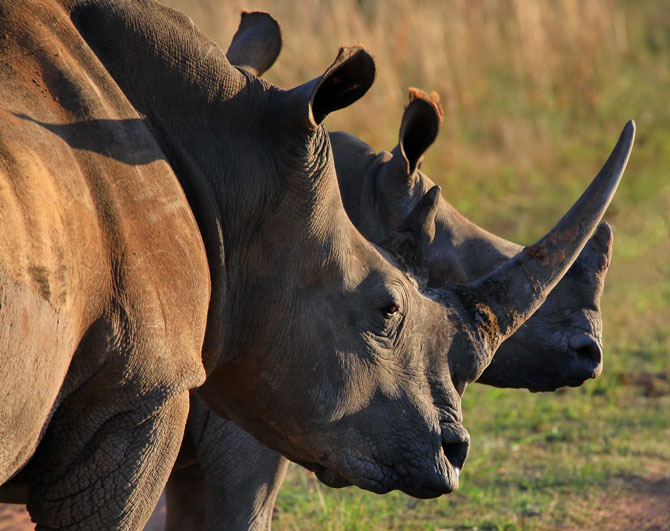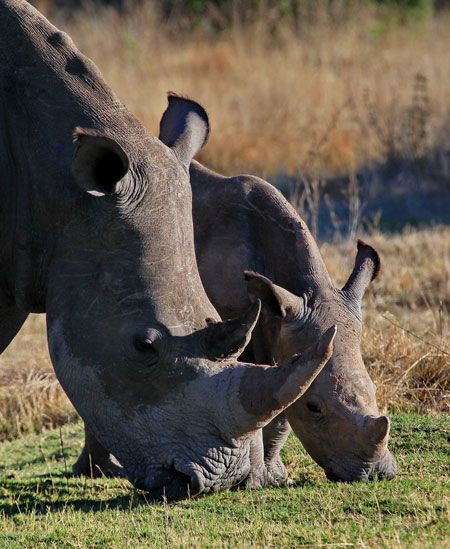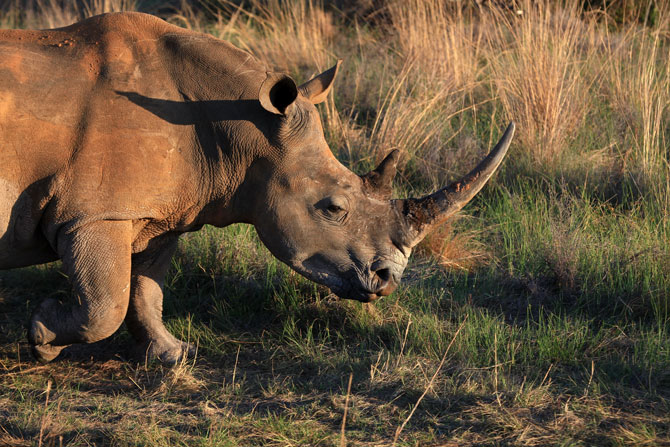We do not get a second chance. If we get the economics of rhino trading wrong all the rhinos in the wild will be gone. We have to get our policies right, and there’s no room for experiments; viewing rhinos in small secure breeding farms is no substitute. The tragedy of the horn debate is that South Africa’s highly respected rhino custodians (park authorities, field rangers, anti-poaching, monitoring teams) and even politicians have embraced a failed, pro-trade economic model as the answer to the rhino crisis.

Let’s look at the economics. Pro-traders argue that the supply of rhino horn can equal demand through free-trade pricing. This may work for large, visible items like Ferraris, but it has not worked for other consumer goods where counterfeiters thrive and expand markets by attracting new buyers by selling goods at discounted prices.
With the real cost of obtaining a rhino horn being a little above the cost of a bullet and a hacksaw, there will always be too much of a price difference between the legal selling price of rhino horn and the cost of poaching that horn. To assume that free-trade pricing economics will stem demand and solve the poaching crisis is nonsense when criminal syndicates can expand markets by supplying discounted goods and perverting the legal market.
The pro-trade price theory simply has not been proven – it is pure conjecture – nor does it take into account the massive potential size of the market. What if the demand for rhino horn is much greater than the supply? With close to a billion potential Asian consumers, this could easily become a reality, especially when criminal syndicates can induce increased demand by selling at prices below those set by the central selling organisation. Then what? The horns of just 25 000 rhinos simply cannot satisfy the demand from just a few million Asian consumers.

Pro-traders cite examples of ostriches, crocodiles, and vicuñas as successes that rhino policies must copy to ensure rhino survival. These are not comparable examples as ostriches etc., breed quickly, and none show the same scarcity levels based on values attached to body parts. Tigers and elephants do, and we’ve seen what trade in their parts has done to wild populations. If trading was the simple answer for all wildlife crises, why don’t we breed and trade tigers (or wild dogs) out of their critical status?
The pro-traders propose that the way to conduct rhino sales is via a De Beers-type Central Selling Organisation (CSO). Many economists out there’ll tell you how cartels serve only their own narrow interests (rhino breeders?) rather than the majority of stakeholders. The De Beers CSO made money for their vested interests but, in the process, certainly didn’t stop ‘blood diamonds’ or illegal parallel markets. Well-organised criminal syndicates will find loopholes around a rhino-horn CSO, providing a legal platform to launder illegal horn. And, will our authorities really be able to run a sophisticated CSO system?
But here’s the crux of the matter. Current international legislation clearly states that there can be no trade in rhino horn. The onus, therefore, must be on the pro-trade lobby to prove that rhino horn trading will unequivocally work, that changing the laws will not be detrimental to rhino populations and will largely do away with poaching and illegal trade. This has not yet been proven, and current pro-trade modelling glosses over these vital areas by making basic assumptions.
We also need to factor in that South Africa has little chance of getting any application for approved seller status through CITES in the foreseeable future. The earliest SA can submit such a proposal for change is 2016, and this merely sets in motion a whole range of bureaucratic procedures and legislative measures. Any change then requires a 75% majority – highly unlikely considering our current administrative malaise – and many more years will be wasted to implement.

With this protracted process in mind, I’m surprised that SA has no ‘Plan B’ because it will need one. My suggestion is that all sides get together and create a strategy that’s a wide-ranging, multi-faceted approach covering the entire scope of the crisis to ensure that rhinos have a chance of surviving in the wild. Here are suggestions (over and above those that are already work in progress):
• To stem the poaching avalanche, we declare all forms of trade in rhino products illegal. This means we must switch mindsets from creating value from rhinos to minimising or, even better, taking away all their value to save them in the wild. It’s a big ask for pro-traders to change mindsets, but the horn must become worthless for rhinos to survive in the wild.
• Very little has been done to target the middleman. They’re the poaching syndicate’s weakest link. Middlemen pay poachers to kill rhinos, and they export the horns. There can’t be too many of them, and some are not hard to spot. Without them, the whole poaching chain would start to implode. Communities will give information if the rewards for poaching information are greater than what they earn from poaching. Lifestyle audits etc will assist. There are laws in Mozambique that allow assets to be confiscated. There are reputable people with the necessary skills, expertise and contacts who are prepared to tackle this problem if given the go-ahead and budget.
• South Africa’s tourism and wildlife policies have often not sufficiently included rural communities living alongside national parks in their business models, and it is from these communities that many poachers emerge. Our wildlife areas are surrounded by rapidly increasing rural populations and extreme poverty. Innovative policies and plans must be put into place to integrate communities into the tourism and wildlife industry’s business models. So long as these neighbouring communities remain marginalised, they’ll seek to claim wildlife, either in their cooking pots or through illicit activities.
To redress this, I propose the creation of a “Natural Capital Fund” to:
1. bolster conservation and anti-poaching work,
2. remunerate and uplift communities who live alongside parks and reserves
3. pay for information leading to the arrest of the middlemen and poachers.
• The South African tourism industry generates well over R100 billion a year. I propose that a 1% levy is charged on all tourism accommodation and related services to support this “Natural Capital Fund”. This could generate as much as R1 billion a year. Getting tourism industry buy-in would take some persuasion, but it’s possible if there was leadership. In my experience, tourists do not mind paying a small levy if they know it’s going to a worthy cause. The funds could be distributed through an impartial and respectable NGO so that the money is spent wisely and accounted for.
• Elevate the crisis to a presidential priority level with Mozambique, Vietnam and China to speed up agreements and implement effective policies.
• We need an Elon Musk/Steve Jobs type of left-field thinking to ensure technology is created to help monitor and protect vast wildernesses such as Kruger.

Some pro-traders concede that their policies may result in rhinos becoming extinct in the wild and only found on small, well-protected farms. Is this what we all want?
The bottom line is: which is the safer bet – testing the insatiability of market demand, or creating an effective Plan B with no trade, ensuring that rhinos survive in the wild? We cannot risk rhinos becoming extinct in the wild and South Africa becoming merely a “Big 4” tourism destination through high-risk economic policies. How many jobs will be lost if that happens?
ALSO READ: Rhino horn trade = extinction in the wild
To comment on this story: Login (or sign up) to our app here - it's a troll-free safe place 🙂.![]()
HOW TO GET THE MOST OUT OF AFRICA GEOGRAPHIC:
- Travel with us. Travel in Africa is about knowing when and where to go, and with whom. A few weeks too early / late and a few kilometres off course and you could miss the greatest show on Earth. And wouldn’t that be a pity? Browse our ready-made packages or answer a few questions to start planning your dream safari.
- Subscribe to our FREE newsletter / download our FREE app to enjoy the following benefits.
- Plan your safaris in remote parks protected by African Parks via our sister company https://ukuri.travel/ - safari camps for responsible travellers






